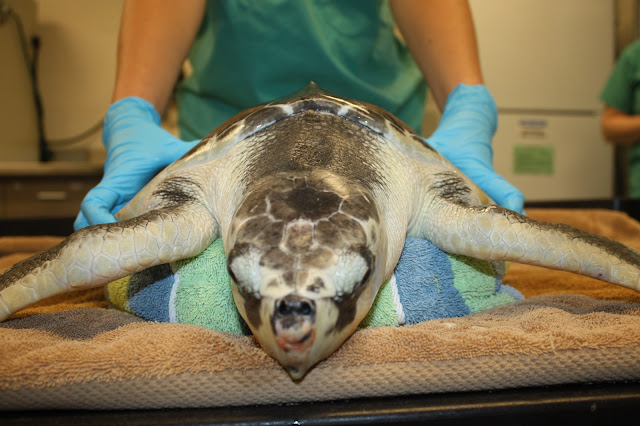Hi all,
It's been a while since I've blogged; guess I was waiting for something really BIG to happen. As many of you know from the wide media coverage, we recently rescued and rehabilitated a giant endangered leatherback sea turtle... a rare and difficult undertaking. (Learn more on the News blog about this here and here.) I plan to tell this story over several blogs due to the importance and detail involved in this rescue effort.
The photo below shows the leatherback as our partners at the Massachusetts Audubon at Wellfleet Bay (WBWS) found him on the morning of September 20, 2012. It is important to note that this animal was actually found the night before at dark out on a mud flat in Truro, MA. It was deemed unsafe to try to remove this animal in mud after dark. For those of you who have never visited Cape Cod, the mud is notorious—you can easily sink to your hips with one step. The midnight tide helped move this animal to a more solid location as seen in the photo below.

The staff at WBWS sent several photos while we were on route with the medical kits. This photo has a unit of measure next to the animal to help us visualize the size of the animal. The WBWS staff, with help from the International Fund For Animal Welfare (IFAW), were able to safely move this animal onto several stretchers and onto one of IFAW's specially designed large animal transport carts. Dr. Julie Cavin and I were able to examine the animal, collect and process a blood sample and provide some emergency support prior to the transport back to our Animal Care Center in Quincy, MA.

Once in our Sea Turtle Hospital, the animal was placed on a large pad of open cell foam while we collected vital information. We collected the same suite of information we collected in the field and compared the two sets. We also collected another blood sample for additional testing. The Aquarium's chief of veterinary medicine, Dr. Charles Innis, was waiting for us upon arrival and began immediate medical treatment based on the blood results and other diagnostic information. We worked as quickly and quietly as possible for less than an hour and then moved the animal into a holding pool.
In the photo below you can see a white discoloration around the eye that is not consistent with normal leatherback sea turtle coloration. This was caused by dermatitis.

This turtle, while large, was under weight for his length and mature status. Weighing in at 655 pounds, this adult male should have been carrying more bulk. The turtle also had several soft tissue injuries that were not life threatening. I will detail those injuries with photos in a later blog.
We wanted the turtle back in water as soon as possible to improve his chances of survival. Because leatherback sea turtles do not do well in confined spaces, we had several challenges. Their pelagic nature means they have never encountered walls. As a result this species will continue to try to swim forward or in every direction until it breaks free and can travel freely.
The photo below shows the leatherback shortly after we placed him in a hospital tank. Dr. Cavin can be seen in the background while two responders in dry suits stand ready to assist the animal if needed. The yellow straps you see around the animal are part of a specially designed turtle stretcher. We left the animal in the stretcher for the first hour or two to help support him in the water.
In the photo below, the turtle lifts his head to take a breath. This photo shows the yellow turtle stretcher, which is not confining his flippers, and black straps that belong to a specially designed leatherback harness. At this stage in his rehab the turtle was still lethargic and made little attempt to challenge the walls of the tank. Photos of the stretcher and harness will appear in greater detail in the next several blogs.

The photo below was taken through the glass of the hospital tank on the first day of rehab. This window allowed us to observe the animal underwater. In the photo you can see the front flipper in the foreground is in motion, the photo was taken as the animal was preparing to lift its head for a breath. By this time the animal was beginning to respond to the supportive care/medical treatment and no longer required the support of the yellow stretcher.
Given that less than a handful of adult leatherback sea turtles have ever been rehabbed anywhere around the globe and even fewer that have survived to go on to be released back into the ocean, this is an important story to tell. Stay tuned for more blogs detailing the chronological events of an incredible effort to save the life of this rare giant turtle.
- Connie


























